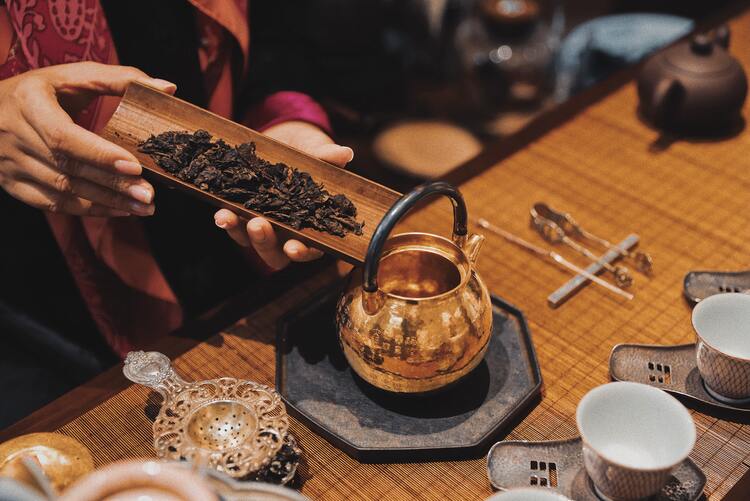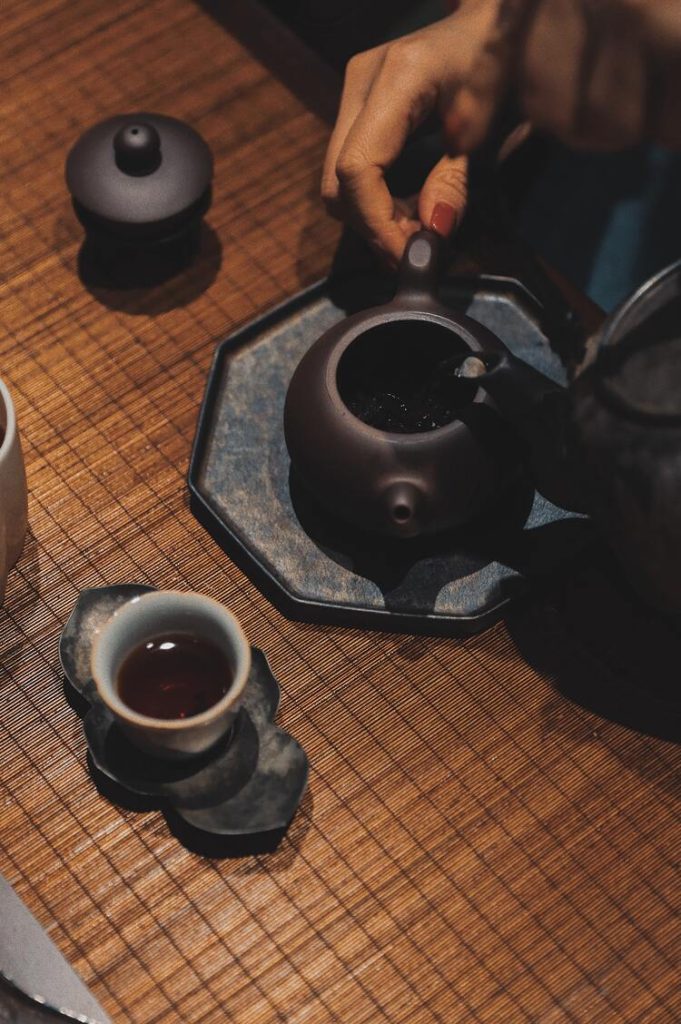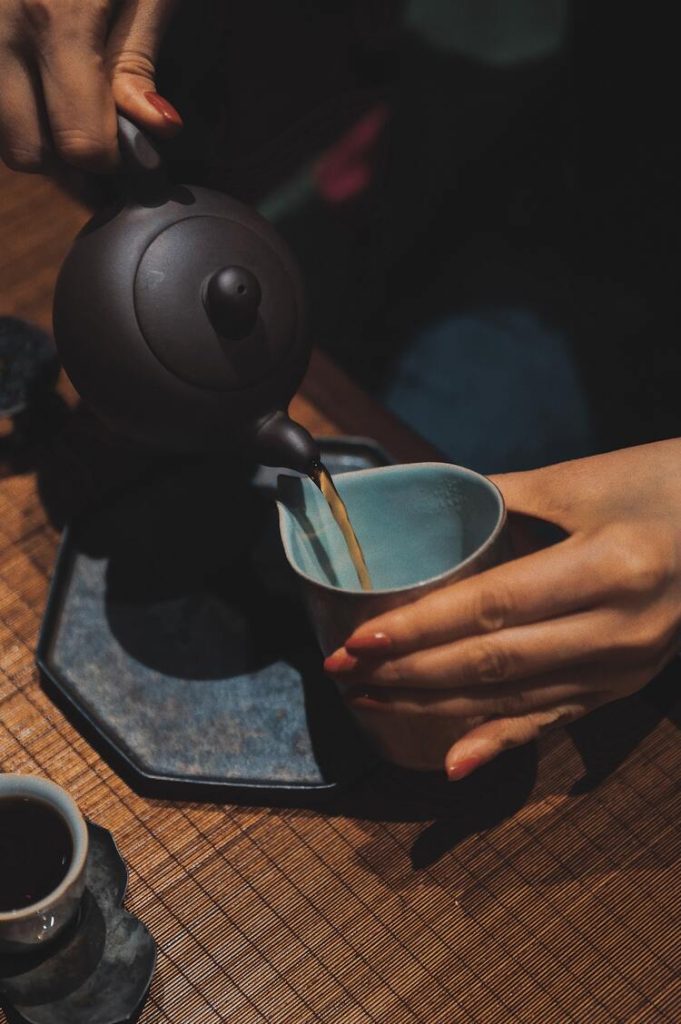Dongfang Meiren tea, also known as Oriental Beauty, is a type of oolong grown in the mountainous regions of Taiwan.
What sets this tea apart from other oolong teas is the way it is processed. The leaves are bitten by a tiny insect called the tea green leafhopper, which causes the leaves to release chemicals that give the tea its distinct flavor and aroma. The tea is then oxidized and roasted, resulting in a sweet, fruity taste with notes of honey and a floral aroma.
Keep reading to learn more about the tea many experts consider one of the finest oolongs in the world.
Please note: This article contains affiliate links, meaning I may earn a commission if you make a purchase by clicking a link. Of course, this comes at no extra cost to you and helps me keep offering readers solid information.

History
Dongfang Meiren, also known as Oriental Beauty or Bai Hao Oolong, is a type of oolong tea that originated in Taiwan. The tea has a sweet and fruity flavor profile with a hint of honey. The tea leaves are also visually distinctive, with white tips and a reddish-brown color.
The history of this tea is said to date back to the late 19th century. Legend has it that a tea farmer named John Dodd observed a group of insects feeding on the leaves of his tea plants. The insects, known as tea jassids, would bite into the leaves, causing the plant to release chemicals that gave the tea its distinctive flavor.
Dodd began cultivating the tea and eventually presented it to Queen Victoria, who was said to be impressed by its unique flavor. The tea became popular in England and was even served to Queen Elizabeth II during her coronation.
Dongfang Meiren is still grown in Taiwan and is considered a premium tea. It is often served on special occasions and is highly sought after by tea enthusiasts worldwide.
Cultivation and Processing
Dongfang Meiren tea is cultivated and processed using specific methods. We get into details below:
Tea Plantation
The tea is typically cultivated in specific regions of Taiwan with suitable growing conditions, including Hsinchu, Miaoli, and Taoyuan areas. These regions provide the necessary climate, altitude, and soil conditions for the tea plants to thrive.
Tea Plant Cultivar
The tea plants used are usually the Qing Xin Da Mao cultivar. This particular variety is known for its tender leaves and the ability to develop the desired flavor profile.
Note: A cultivar is a plant cultivated to yield specific characteristics. Cultivars are not true to seed, which is propagated through cutting, grafting, and other methods.
Timing
The cultivation process for Dongfang Meiren involves a unique aspect related to insect feeding. Tea leaves are plucked during a specific time when the tea plant’s new shoots are bitten by small leafhopper insects (scientific name is Jacobiasca formosana). These insects’ presence and feeding on the leaves stimulate the tea plant to produce certain compounds that contribute to its distinctive flavor.
Organic and Sustainable Practices
Dongfang Meiren tea is often cultivated using organic and sustainable farming methods. This approach minimizes chemical pesticides and fertilizers, allowing the tea plants to grow naturally and produce high-quality leaves.
Harvesting
Once the leafhoppers have fed from tea leaves, they are carefully handpicked by experienced tea farmers. Only the topmost leaves and buds are plucked, ensuring the highest quality and flavor concentration.
Processing
After harvesting, the tea leaves undergo a specific processing method. They are withered and oxidized to a certain degree, crucial in developing the tea’s unique flavor.
Oxidation is a natural process when tea leaves are exposed to air. During oxidation, enzymes in the tea leaves break down the cell walls and release the tea’s natural oils. The longer the tea leaves are exposed to air, the more oxidized they become. Dongfang Meiren oxidized about 70%. This oxidation level is high in comparison to other Taiwanese oolongs.
The oxidation process is carefully controlled and monitored to achieve the desired balance.
Roasting
Following oxidation, tea leaves are gently roasted to halt the oxidation process and further develop the flavor. The roasting step is critical in shaping the tea’s aromatic profile, enhancing its complexity and richness.
Final Preparation
Once the tea leaves have been roasted, they are sorted, graded, and packaged for distribution and sale. The completed product is highly regarded for its beautiful appearance, with twisted leaves exhibiting green, red, and silver shades.

Characteristics of Dongfang Meiren Tea
Dongfang Meiren is a highly prized oolong tea that has captured the hearts of tea lovers worldwide. Here are some of the characteristics that make this tea so special:
Fragrance
Dongfang Meiren is known for its sweet, honey-like aroma that is refreshing and soothing. The scent is often compared to ripe peaches, making it a perfect tea to enjoy on a warm summer day.
Appearance
The leaves of this are characterized by their white tips, which give the tea a delicate and elegant appearance. The leaves are rolled into tight balls, which unfurl when brewed, revealing their beautiful colors and textures.
Flavor
The flavor of Dongfang Meiren is complex and nuanced. Here are the characteristic flavors associated with it:
- Sweetness: The tea is known for its natural sweetness, often honey-like or fruity. This sweetness results from the tea plant’s response to insect feeding during cultivation, which triggers the production of certain compounds.
- Floral Notes: The tea exudes captivating floral aromas and flavors. You may detect hints of jasmine, rose, orchid, and other fragrant flowers.
- Fruity Undertones: Dongfang Meiren exhibits subtle fruity notes that enhance its complexity. You might notice hints of ripe peaches, apricots, lychees, or tropical fruits.
- Mellow and Smooth: This tea is typically mellow and smooth, with a velvety texture. It lacks the astringency often found in other oolong teas, making it a delightful drink.
- Complexity: The offers a multi-dimensional flavor experience. Its taste evolves with each steeping, revealing different nuances and layers. Some people even detect a slight muscatel flavor while sipping the tea (a common characteristic of Darjeeling teas; Darjeeling is a region of India known for its black tea production). It is known for its long-lasting aftertaste, allowing you to savor the tea’s flavors even after drinking.
- Subtle Spiciness: Some tea variations may have a slightly spicy note reminiscent of cinnamon or clove. This adds a touch of warmth and depth to the overall flavor profile.
Other Names and Varieties
When it comes to Dongfang Meiren, you might hear it being referred to by various other names. The most common names include Peng Feng, Champagne Oolong, Bai Hao Oolong, White Tip Oolong, Silver Tip Formosa, Silver Tip Oolong, and Braggart’s Tea. These names are often used interchangeably and refer to the same type of tea.
The tea is grown in different regions, and as a result, there are some variations in taste and appearance.
One of the most popular varieties is the Beipu Dongfang Meiren, grown in the Beipu Township of Hsinchu County. This variety is known for its fruity and floral aroma and is considered one of the best types of Dongfang Meiren.
Another popular variety is the Emei Dongfang Meiren, which is grown in the Emei Township of Hsinchu County. This variety is known for its smooth and mellow taste and is often considered a good choice for beginners.
In addition to these varieties, there is also Peng Feng Cha, a type of Dongfang Meiren grown in the Peng Feng Township of Taiwan. This variety is known for its sweet and fruity taste.
Finally, the Siyen Hakka variety is grown in the Siyen Township of Hsinchu County in Taiwan. This variety is known for its strong and bold flavor and is often considered a good choice for those who prefer a stronger tea.

Brewing Dongfang Meiren Tea
Gong Fu Brewing Method
If you want to enjoy the full flavor of Dongfang Meiren, then the Gong Fu brewing method is recommended. This method involves using a small teapot (Yixing clay teapot) and brewing the tea in multiple short infusions. This brewing method ensures the best taste. Here’s how you can do it:
- Preheat your teapot and cups by rinsing them with hot water.
- Add about 5-6 grams of tea leaves to the teapot.
- Pour hot water over the tea leaves and immediately pour it out. This helps to rinse the tea leaves and awaken their flavor.
- Refill the teapot with hot water and let it steep for about 20-30 seconds.
- Pour the tea into your cups and enjoy the fragrant aroma and delicate taste.
- Repeat steps 4 and 5 for multiple infusions, gradually increasing the steeping time with each infusion. You can increase the steeping time by 10 to 20 seconds for each infusion
Please pay attention to the last step. You can (and should) infuse your oolong tea multiple times. Please make the most out of it!
Gaiwan Brewing Method
You can use a gaiwan to brew tea as well. A gaiwan is a traditional Chinese tea brewing vessel that allows you to control your tea’s temperature and steeping time. Here’s how to use it:
- Warm the gaiwan and tea cups with hot water,
- Add the tea leaves to the gaiwan. Use about 3-6 grams of tea per 100ml of water.
- For heavily roasted oolongs, pour hot water over the tea leaves and immediately pour it out. This helps to rinse the tea leaves and awaken their flavor.
- Slowly pour water over the leaves till the rim of the gaiwan.
- Add the lid and steep for 20-30 seconds.
- Pour the tea into teacups. While doing this, hold the gaiwan with your thumb and middle finger. Secure the lid with the index finger.
- Repeat the process with multiple infusions.
Western Style Brewing
If you prefer to brew tea using Western methods, start by heating the water. Put one teaspoon of tea leaves into a tea infuser or strainer, and place it in a cup. Pour the hot water over the leaves and let it steep for about 3-4 minutes. Remove the infuser or strainer, and enjoy your tea.
Ideal Water Temperature
The water temperature plays a crucial role in brewing this tea. If the water is too hot, it can burn the delicate tea leaves and ruin the flavor. On the other hand, if the water is too cold, it may not extract the full flavor of the tea leaves. Here’s the ideal water temperature for brewing this particular tea:
- Bring fresh, cold water to a boil.
- Let it cool down for 2-3 minutes until the water temperature reaches around 190-200°F (88-93°C).
- Pour the hot water over the tea leaves and let it steep for the desired time.
Remember to use fresh, cold water that is free of any impurities. Avoid tap water if possible, as it may contain chlorine or other chemicals that can affect the taste of your tea.
Dongfang Meiren Tea Health Benefits
Drinking Dongfang Meiren can provide a wide range of health benefits. This tea is packed with active elements that can help boost your immune system, improve your cardiovascular health, and maintain healthy cholesterol levels.
Studies have shown that regular consumption of oolong tea can help reduce the risk of certain types of carcinoma, including breast and lung cancer. This tea also contains antioxidants that can help protect your cells from damage caused by free radicals.
Dongfang Meiren is also known for its ability to help regulate blood pressure levels. This can help reduce the risk of heart disease and stroke. Additionally, this tea contains fluoride, which can help strengthen your teeth and prevent cavities.
Regarding stamina, the tea contains caffeine, which can help improve your energy levels. This tea is also rich in minerals such as phosphorus, calcium, magnesium, iodine, and zinc, which can help support overall health and well-being.
Buying Recommendations
When it comes to buying Dongfang Meiren, you have some options.
A great place to buy this tea is at specialty tea shops. These shops often carry a wide variety of tea blends. You can find loose-leaf tea or tea bags, depending on your preference. Specialty tea shops are also the place to ask questions and get recommendations from knowledgeable staff members who can help you find products according to your preferences and budget.
If visiting a specialty tea shop is not viable, you can look for reputable online tea shops or retailers. You can also read reviews from other customers to get an idea of the quality of the tea and the seller’s reliability.
Here are some recommendations:
Oriental Beauty Taiwan Oolong Tea

Oriental Beauty Tea Taiwan High Mountain Tea

Frequently Asked Questions
What does Dongfang Meiren taste like?
Dongfang Meiren, also known as Oriental Beauty, has a unique flavor that is sweet and fruity with a hint of honey. It is known for its complex flavor profile, including peach, apricot, and muscatel notes.
What type of tea is Oriental Beauty?
Oriental Beauty is a type of oolong tea that is grown in Taiwan. It is made from the tea plant leaves that a small green leafhopper has bitten. This insect bite causes the leaves to oxidize and develop a unique flavor profile.
What are the other names for Oriental Beauty tea?
Oriental Beauty tea is also known as Bai Hao Oolong, White Tip Oolong, and Champagne Oolong. These names refer to the tea’s appearance, including white leaf tips and a light, champagne-like color.
What is the caffeine content of Oriental Beauty tea?
Oriental Beauty tea is a type of oolong tea, which means it contains caffeine. However, the caffeine content can vary depending on factors such as brewing time and temperature. A cup of Oriental Beauty tea contains around 30-40 mg of caffeine.
What is the history of Dongfang Meiren tea?
The history of Dongfang Meiren tea dates back to the 19th century in Taiwan. Legend has it that a tea farmer discovered the unique flavor of Oriental Beauty tea after green leafhoppers bit his tea leaves. Since then, the tea has gained popularity worldwide for its complex flavor and aroma.
I hope you enjoyed the article and learned something new. See you next time!
Have you tried this tea?